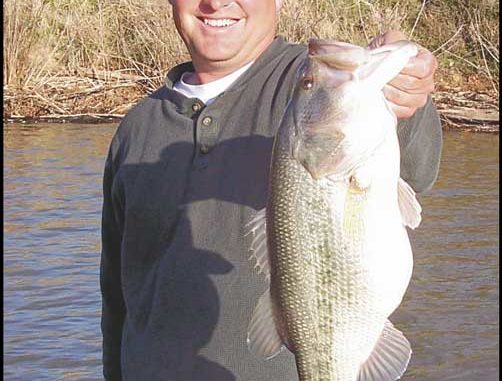
No quicker way exists to load a boat with bass than when they’re schooling on the surface. When bass are in a school and franticly feeding, an angler has no time to waste. Everything with his tackle must be perfect ahead of time, and he must make perfect casts to capitalize on this opportunity.
Bass school throughout the year, but summer is the most predicable time.
During my last professional bass tournament, I spent two hours each evening preparing for a 30-minute window of schooling action. The result was quick limits of nice bass early in the morning.
If you have to take time to change lures and untangle your tackle, the chance for this quick action will slip through your fingers even more quickly.
Two distinct types of schooling activities occur — an early-morning shad or herring-spawn school and an open-water or “point” school when bass feed on compact schools of shad.
The open-water schools are often better at mid morning or the middle of the day while the shad spawn only lasts an hour or so in the morning.
So where should anglers look for schooling activity? Two situations usually dictate when the fish school bell rings.
Schooling bass are almost always near some type of structure and affected by wind. A really good chance to find surfacing feeding bass occurs when the wind blows onto or across certain structures. For example, huge schools of bass sometimes gather to trap shad at the backs of coves when the wind blows directly toward the back.
Points also are good to check. Most good points are long, skinny and shallow and have rocks. Rocks attract shad that often spawn there and such rocks draw largemouths like magnets in the water.
The mega-schools of bass I’ve seen in the past usually were channel- or sharp-break related.
The channel also is a sharp break, but other structure sources could be a road bed or a rock pile at a flat. During the shad spawn at the banks, check points with bird activity — herons and sea gulls.
But catching schooling bass can be frustrating. Sometimes bass selectively feed on a certain size, color and speed of lure while at other times they want something completely different.
When schooling bass are actively busting baitfish on the surface, it’s hard to beat a topwater lure.
I prefer walking baits, such as a Team Daiwa Pencil. If fish are reluctant to take topwater lures, a soft jerkbait such as the Culprit Jerkworm is deadly.
If the fish are down on the structure and apparently not actively feeding, a swimbait such as a Basstrix can work well when fished on a jighead.
The swimbait often gets the biggest bass in the school. I’ve seen times when small spoons were the only lures bass would bite. Other times lipless crankbaits were the key.
For shad that are spawning at the bank with schools of bass chasing them, a white Chatterbuzz is effective if fished parallel to the shore.
And don’t forget jerkbaits.
You see why it can take two hours to rig for schooling bass.
Perhaps the biggest dilemma in trying to catch open-water schoolers is whether to chase them or not. Often it seems a school moves fast and busts just out of lure range. In that case, should you crank up the motor and get closer?
Often when you do, you’ll turn around to see bass busting the area you just vacated.
The more you fish for schoolers, the better idea you’ll have whether to chase them or not. Sometimes if pays off to chase them.
What I’ve found to be a good solution is to have one lure rigged that you can absolutely bomb out there (such as a pencil pop or heavy spoon to reach those distant schools).
Some guys cast these lures with 20- or 30-pound braid that has the equivalent of 6- or 8-pound-test monofilament diameter (they can get more line on their reels).
With a spoon or pencil pop, you can cast all your regular line off a reel, so be sure to fish these long-casting lures with line spooled on a 7.1:1 gear-ratio reel (I use a Daiwa Zillion). That way you can retrieve your lure quickly if you miss the school or don’t get a bite.
The bottom line is fishing for schooling bass is fun but can be frustrating.
The key is to be ready when bass pop to the top so you end up on the fun side more often than not.
Dustin Wilks is a 31-year-old professional bass angler and Raleigh native now living in Rocky Mount. He has qualified for the Bassmaster Classic four times and operates Fish Like a Pro Fishing Lessons (252-883-6749, www.fishlikeapro.com ). His sponsors include Assassinator Spinnerbaits, Chatterbuzz, Skeeter Boats, Yamaha, Daiwa, Keelshield and Culprit.



Be the first to comment